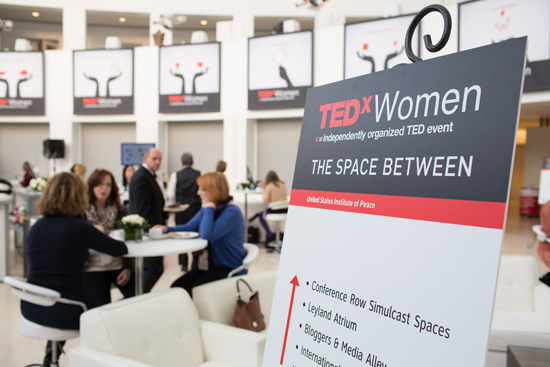
Over the past two days, TEDxWomen brought together 50 speakers from around the globe, each giving a different slice of thinking on the state of women today. Here, a selection of the powerful talks from this event, which was produced and curated by The Paley Center for Media.
Session 1: The space between Poverty and Plenty
Malehlohonolo Moleko, small business owner Malehlohonolo boarded an airplane for the first time ever this week, flying from her home in South Africa to Washington, D.C., for TEDxWomen. In 2006, Moleko started a baking business and took out a loan from a bank. But she quickly realized that she had no idea how to manage accounts. “It was so embarrassing,” says Moleko of falling behind on payments and not being able to afford ingredients. Luckily, Moleko found a training program for women in business and it turned her prospects around. Her idea: end poverty by making business education and mentorship available to women. Says Moleko, “When you are determined to work hard and wise enough to seek help, anything is possible.”
Jacki Zehner, investor and philanthropist. Jacki is being the youngest woman and first female trader to become a partner at Goldman Sachs. But in 2002, she left the company with a mission: to create a guide for those interested in seeing more female faces in board rooms and on trader floors. In this talk, Zehner calls on us all to support companies that show they respect female leadership, to sponsor female innovators on Kickstarter and to urge venture capitalists to fund female-headed startups. (As Gayle Tzemach Lemmon shared in her talk, which opened the session, only 5% of venture capital goes to women.) Zehner says, “What we buy and who we buy it from is one of the most important decisions we make every day. Imagine if we used that power.”
Rosie Rios, Treasurer of the United States. Rosie Rios is the 43rd Treasurer of the United States, and her name is, literally, on your money. When she met Carlos Slim, the richest man to the world, at a luncheon in 2010, she joked to him, “I’m probably the only person in the world who makes more money than you do.” In this heartfelt talk, Rios describes being one of eight children raised by a single mother. And she shares great pride in the fact that there are currently seven confirmed women in the Treasury — the most of any administration — and in the fact that they have set up a permanent exhibit about the women in the Treasury.
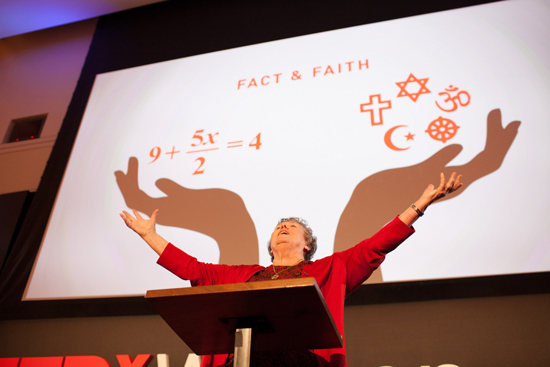
Session 2: The space between Fact and Faith
Sister Joan Chittister, Benedictine nun. Sister Joan began her talk with a bold statement: “The second class status of women in our society has always been a matter of faith.” She delves into the roots of it — the Abrahamic creation story in which man was created first. But as Chittister says, “Darwin is reshaping the way we think about creation. We are at crossover moment in time — what was considered true up to this time will not be considered true after this time … Science is giving us a God big enough to believe in.” Instead of a God who personally designed the features of our world in one swoop, could it be that creation is a work in progress. And that each of us plays a part?
Eboo Patel, interfaith youth leader
Eboo Patel’s grandmother constantly urged him to marry a nice Muslim girl. It was a message he wasn’t interested in hearing as a student at the University of Illinois at Urbana-Champaign, feeling intense anger at the injustices of the world. In making his way as an activist, Patel was introduced to the work Dorothy Day of the Catholic Worker movement, who he calls “the most radical person of 20th century” for her generosity. When he realized that Day was delivering the same message as his grandmother — that God is at the root of caring for others — he finally embraced his religion. Now an interfaith leader, Patel says, “The reason I’m on this path is because of two female faith leaders.”
Session 3: The space between IQ and EQ
Charlotte Beers, advertising legend. In a story-filled talk, Charlotte gives advice to women when it comes to work. First, know yourself — including your negative traits and the baggage you carry. Second, speak with clarity and cultivate persuasiveness. “Be prepared to step out of the team and say, ‘I believe.’ Have them understand that you mean it and they will believe you,” she says. “When you turn around, they’re following you. That is leadership … I just want you ready for every single moment of leadership that comes your way.”
Shabana Basij-Rasikh, education advocate. When the Taliban fell in Afghanistan, Shabana remembers what her father said: “You can go to a real school now.” In her household, education was treasured — even for girls. Basij-Rasikh went on to attend Middlebury College and, on a break in Kabul, there was an attempt on her father’s life. The bombers called the house, and told her father not to send her back to college. In an emotional talk, Basij-Rasikh recalls her father’s brave words: “Kill me now if you wish, but I will not ruin my daughter’s future because of your old and backwards ideas.” Watch Shabana’s TED Talk: Dare to educate Afghan girls.
Brittany Wenger, Google Science Fair winner. “I was that kid who never outgrew the ‘why’ phase,” says 17-year-old Brittany. In this talk, she shares how — after her cousin battled breast cancer — she had an idea to combine her interests in medical research and computer science to improve breast cancer detection. Essentially, Wegner taught a computer to answer the question, “Is this tumor malignant or benign?” with 99.1% accuracy. Wegner’s artificial neural network should only get more accurate with more samples and her work could make the least invasive test for breast cancer, fine-needle aspiration, the most effective. Read our interview with Brittany Wenger.
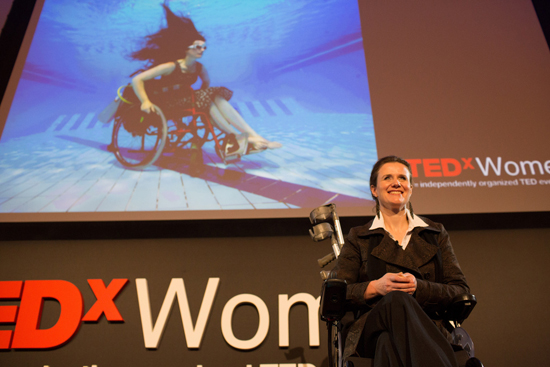
Session 4: The Mirror, the space between what we see and what we reflect
Sue Austin, artist. When Sue got her wheelchair, she felt a tremendous sense of freedom. But at the same time, she says, “It was as if an invisibility cloak descended,” with others seeing her chair as a symbol of loss and limitation. Austin decided to use art to bridge the gap between how she viewed herself and how others saw her. A must-see example: this video of Sue exploring a coral reef in an underwater wheelchair, which unites a chair with scuba gear. Watch Sue’s TED Talk: Deep-sea diving … in a wheelchair
Anita Sarkeesian, media critic. Anita had what she thought was a simple idea: to make a series of videos exploring the tropes of women in video games. But when she posted the project on Kickstarter, she got a reaction she never expected — a tidal wave of hate. For anyone who thinks that being online bullied is no big deal, she shows some of the messages she received — many threaten rape and some death.Her critics circulated her phone number and her home address. But many stepped up to Sarkeesian’s defense, donating to her Kickstarter initiative. While she had set out to raise $6,000, in the end she raised nearly $159,000.
Angela Patton, community leader. Angela works with teenage girls, and knows there is one relationship they crave: their relationship with their father. In this talk, Patton explains how she and her students dreamed up the idea of a father/daughter dance. And how, since one of the girl’s fathers was in jail, they brought the event to the prison. Watch Angela’s TED Talk: A father-daughter dance — in prison.
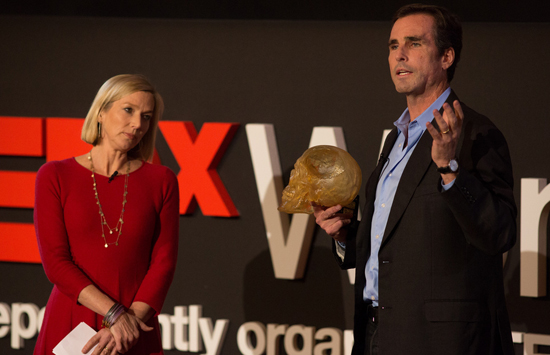
Session 5: The space between life’s Stops and Starts
Bob and Lee Woodruff, journalist and author. Lee Woodruff was at Disney World with her four children when she got the call that her husband, Bob Woodruff — who had just been appointed the co-anchor of World News on ABC — had been hit by a roadside bomb and was in a coma. “You can’t ask, ‘Why me?’ You don’t have time to ring your hands,” says Lee. “You can be bitter or you can get better.” In this banter-filled talk, Bob shares details of his physical recovery and Lee reveals how she relied on four ‘f’s to get her through: family, friends, faith and funny. In their home a sign now reads, “If it’s not fatal, it’s fine.”
Janine di Giovanni, war correspondent. “This is how war starts—one day you’re living your ordinary life … Next thing, the telephones go out, the TV goes off and there are armed men on the streets,” says journalist Janine di Giovanni. “People don’t want to believe war is coming.” In this powerful talk, di Giovanni shares that the conflict that affected her most was Sarajevo, where people lived under siege without water, power, electricity and food for three years. While the devastation and loss of life was terrible, di Giovanni says that she also saw incredible love there. On Saturday, Di Giovanni will head back to Syria. So why does she continue to cover war? As she explains, “What I see is incredibly heroic people fighting for things we take for granted every single day.” Watch Janine’s TED Talk: What I saw in the war
Session six: The Rising, the space between Seeing and Doing
Isatou Touray, women’s health advocate. Isatou was 10 years old when she came home to a big celebration, full of costumes in dance. Says Touray, “I thought, ‘This is the day I’m to be a woman.’” Instead, her genitals were mutilated. Touray could never understand how this was a part of her faith. Today, Touray’s organization — GAMCOTRAP — is dedicated to eradicating genital mutilation in The Gambia, a fight which has sent her to jail 66 times. “We have to come together and save the next generation from this dangerous practice,” she says.
iO Tillett Wright, photographer. As a child, iO lived as a boy — going as far as to turn around her shoes in bathroom stalls so it would look like she was standing up. But as she grew up, she reframed her identity as a tomboyish girl who had been in love with women and men. “I wasn’t asked to define myself by my parents,” says Wright. “I was just told to be me, growing and changing at every moment.” It’s from this standpoint that Wright approaches what she calls “the civil rights cause of my generation.” On the stage, Wright shared images from her series, Self-Evident Truths, for which she photographed 2,000 people who consider themselves anywhere on the LBGTQ spectrum. As she found, most people consider themselves to exist in the grey areas of sexuality, which presents a problem when it comes to discrimination. “Where exactly do you draw the line?” says Wright. “Where exactly does someone become a second class citizen?” Watch iO’s TED Talk: 50 shades of gay.
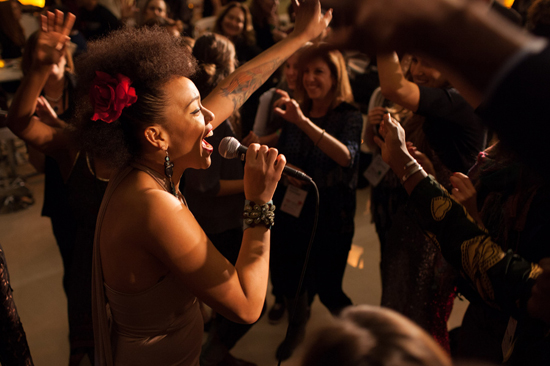
Photos by Ryan Lash
Comments (6)
Pingback: The best of the web | TEDWomen 2013 – Invented Here
Pingback: Local Government Election: Touray calls his arrest and detention ‘a setup’ | Front Page International
Pingback: TEDxWoman 2012: The Space Between « In an Irish Home
Pingback: TEDxValenciaWomen, o Cómo ser contraproducente - Esceptica